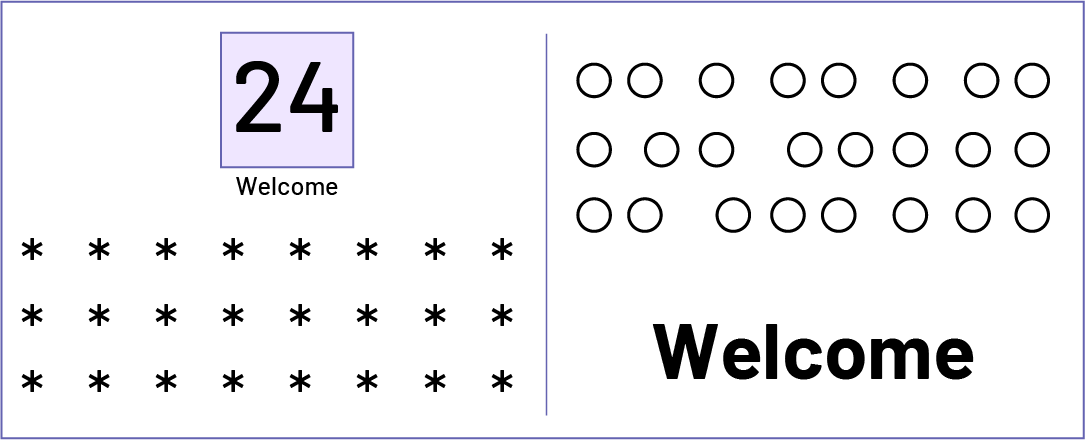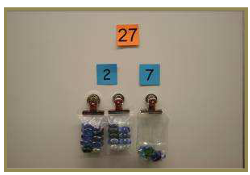B1.4 Estimate the number of objects in collections of up to 50, and verify their estimates by counting.
Activity 1: Welcome to Our Home (Estimating, Cardinality)
Directions
Explain to students that the principal has asked each class group to put a welcome sign on its door and that the number of students in the class should be included and represented with symbols or drawings.
Ask students to estimate the number of students in the class.
Write the estimations on the board and discuss the likelihood of the answers.
Check the estimations by counting.
Group students into pairs and ask them to create a poster.
Circulate among the students and ask them to explain their approach and reasoning. After the posters have been completed, ask students to post them on the board.
Ask students to compare two posters: one with the total number of students and one without.
Ask students the following questions:
- What is similar about the posters? What is different?
- What does the number 24 represent? (Point out the link between the number 24 and the stars: cardinality of a number.)

Source: translated from Guide d’enseignement efficace des mathématiques de la 1re à la 3e année, Numération et sens du nombre, p. 51-52.
Activity 2: Counting Strategies
Provide opportunities for students to solve problems using their own strategies which could include counting.
Provide opportunities for students to play games that promote counting strategies; for example, games that involve moving tokens along a line or path and keeping track of counts as moving forward or backward. These games should include numbers in the tens whenever possible; for example, games that use two-digit numbers on a hundreds mat.
Provide students with counting activities related to daily life; for example, counting the line at the door.
Make manipulatives, such as counters, hundreds grids, and vertical and horizontal number lines, available to students.
Provide opportunities for students to explore the numbers 5 and 10 as anchors or benchmark numbers for all other numbers.
Provide opportunities for students to use a variety of counting strategies.
Source: translated from Guide d’enseignement efficace des mathématiques de la 1re à la 3e année, Numération et sens du nombre, p. 5.
Activity 3: Object Collections (Counting)
This activity can be done from month to month and takes into account the days of the current month, so there will always be 28 to 31 objects per month. The objects chosen for the collection can be related to a theme, a season, a show, etc. The objects can be placed in a small clear plastic bag, a cut-out box attached to the wall, etc.
Each day, a student puts an object in the bag or box holding the collection. On Mondays, have a student add the objects for Saturday and Sunday.
The objects can be placed in a small clear plastic bag, a cut-out box attached to the wall, etc.
When the collection reaches 11, 21, and in some cases 31 objects, add another bag or box to make a group of 10. It is important that students can see the objects.
Note: When students know that there are 10 objects in the bag or box, they are less likely to start counting again.
Display small cards on top of the bags or boxes to indicate the symbolic representation of the number. Explain to students what the numbers mean when you display them; for example, for 27, you would display a "2", which represents 2 groups of 10 objects, which makes 20, and a "7", which represents the extra objects in the other bag. So you can have them say, "2 groups of 10 and 7 more is 27".
At the end of each month, objects are removed and a new collection is started. By starting the collection of objects again each month, students have the opportunity to practice the pattern of numbers from 1 to 31 and associate an object with each day (one-to-one correspondence). Numbers that are more difficult to learn, such as 11, 12, 13, 14, 15, 16, are reviewed each month, and students build a better understanding of these numbers by seeing their different representations concretely and symbolically. Those with a more solid understanding make fewer digit reversal errors in numbers, such as 21 and 12, and can better explain their values.
Each day, count the objects with the students. During this counting activity, add noise when you say a multiple of 10 to remind students that a group of 10 has been formed. For example, snap your fingers, tap your thighs, or clap your hands. Towards the end of the month (for example, 29), ask students if there is another way to count other than in increments of 1. A student may suggest starting at 10. You can then do it together: 10 (snap), 11, 12… 29.

Ideas for Object Collections
Counters, buttons, plastic animals, marbles, shaped erasers, straws, pencils (bundled with an elastic band), stickers and ten frames, self-inking stamps (paper plates), stamps, pasta, cotton balls, coins (1 cent and 10 cents), etc.
Source: translated from L’@telier - Ressources pédagogiques en ligne (atelier.on.ca), p. 1-2.
Activity 4: Identify the Error
To play this game, students will observe and correct the teacher who incorrectly counts objects:
- The teacher counts a set, such as money, books, blocks, or pencils, but gets it wrong and has an incorrect count.
- The teacher could forget a number or count an object more than once.
- Students must find the error.
- Students could also be invited to take turns leading the game.
Source: translated from Guide d’enseignement efficace des mathématiques de la 1re à la 3e année, Numération et sens du nombre, Document d'appui, p. 5.
Activity 5: Estimate the Number
Prepare two containers of the same size, one with larger objects and the other with smaller objects, such as golf balls in one and small marbles in the other. Count the golf balls with the students. Ask them if they think the amount of balls in the second container is smaller or larger. Ask them to think about it and discuss it with a peer, then justify their answer.
Another week, use the same containers. Fill one a quarter full with objects, such as small plastic dinosaurs, and fill the second one completely with the same objects. With the students, count the objects in the first container. Ask them to estimate the number of objects in the second container. Students can estimate the quantity in the second container by referring to the known quantity in the first. Ask them to explain their estimate, then count the objects in the container.
Another week, continue the estimation activities by preparing two containers of different sizes filled with the same objects.
With the students, count the objects in the first container.
Ask students to estimate the number of objects in the second container. Ask them if the known quantity of the first container can help them make their prediction. Check their predictions by counting the quantity in the second container.
Each week, discuss estimates and actual quantities. Vary how you check the number of elements in the containers:
- count them with the students;
- count them in the math centre in small teams;
- count them while projecting them onto the screen while placing the objects in 10 frames.
While counting the objects to check the accuracy of the estimates, ask if any students would like to change their original estimate once you approach half the container.
Discuss with students what estimating means so they do not worry about getting the right answer. Estimating should not be a competitive activity. Encourage students to feel comfortable estimating and to understand that estimating is not about getting the exact answer.
When you provide students with benchmarks and present them with strategies like the ones mentioned above, they can give plausible estimates instead of wild ones.

Source: translated from L’@telier - Ressources pédagogiques en ligne (atelier.on.ca), p. 1-2.
